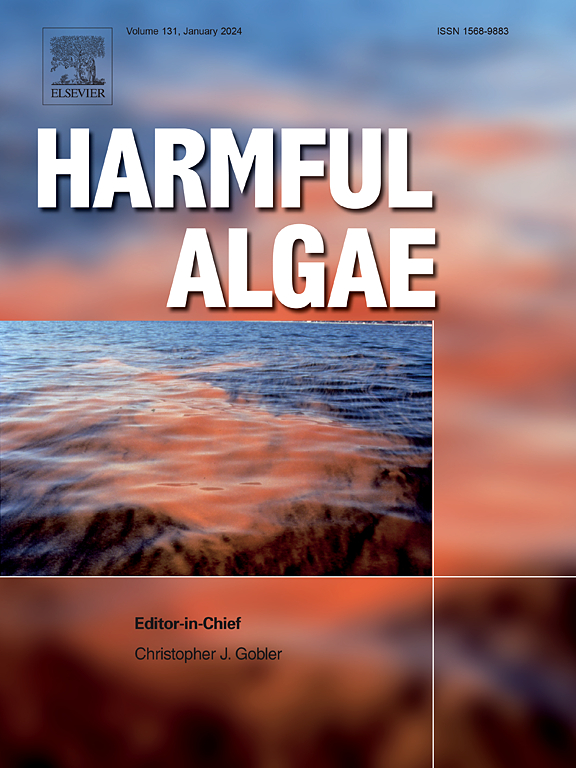Intraspecific variability within Karlodinium armiger (Dinophyceae) on a toxicological and metabolomic level
IF 4.5
1区 生物学
Q1 MARINE & FRESHWATER BIOLOGY
引用次数: 0
Abstract
The species Karlodinium armiger occasionally co-occurs with Karlodinium veneficum during harmful algal blooms. The only toxin of this species described so far is karmitoxin, a highly ichthyotoxic compound very similar to the karlotoxins produced by K. veneficum. However, information on K. armiger is limited and based on a single Mediterranean strain (K-0668), with few studies investigating its toxicity. Given the high intraspecific variability known in K. veneficum, it was a significant achievement when two additional strains of K. armiger (MD-D6 and MD-D7) were isolated from the Labrador Sea in 2017, enabling comparative studies within this species. The toxicity of these three strains was assessed using the fish gill cell line RTgill-W1 and the cryptophyte Rhodomonas salina. An untargeted metabolomics approach using high-resolution tandem mass spectrometry, along with a computational workflow, provided insights into the metabolomic differences between the strains. Despite being cultivated under identical conditions, the metabolomic profiles and toxicological properties were distinct, even between MD-D6 and MD-D7, which were isolated from the same water sample. While MD-D7 did not exhibit significant toxicity, MD-D6 showed high toxicity and lytic potential, similar to K-0668. Interestingly, karmitoxin was only detected in K-0668, and neither karlotoxins nor any known analogs were detected in any strain. Within this comprehensive workflow, some molecules were found in MD-D6 that share the same chemical space as karmitoxin, making them interesting targets for further research. In conclusion, this study evaluated the toxicological and metabolic variability in three different strains of K. armiger and identified some putative toxin candidates in MD-D6.
甲藻科甲藻的毒理学和代谢组学水平的种内变异
在有害藻华期间,armiger Karlodinium偶尔与veneficum Karlodinium共存。迄今为止所描述的该物种的唯一毒素是核毒素,这是一种高度鱼毒性的化合物,与veneficum产生的核毒素非常相似。然而,关于阿米格伊蚊的信息是有限的,而且是基于单一的地中海菌株(K-0668),很少有研究调查其毒性。考虑到veneficum已知的高度种内变异性,2017年从拉布拉多海分离到另外两株阿米格氏克雷默氏菌(MD-D6和MD-D7)是一项重大成就,可以在该物种内进行比较研究。用RTgill-W1鱼鳃细胞系和隐殖盐红单胞菌对这3株菌株进行毒性评价。使用高分辨率串联质谱的非靶向代谢组学方法,以及计算工作流程,提供了菌株之间代谢组学差异的见解。尽管在相同的条件下培养,但即使从同一水样中分离出来的MD-D6和MD-D7之间的代谢组学特征和毒理学特性也是不同的。MD-D7没有表现出明显的毒性,MD-D6表现出高毒性和裂解电位,与K-0668相似。有趣的是,核毒素只在K-0668中检测到,而核毒素和任何已知的类似物都没有在任何菌株中检测到。在这个全面的工作流程中,在MD-D6中发现了一些与核丝毒素具有相同化学空间的分子,使它们成为进一步研究的有趣目标。总之,本研究评估了三种不同菌株的毒理学和代谢变异,并确定了MD-D6中一些可能的候选毒素。
本文章由计算机程序翻译,如有差异,请以英文原文为准。
求助全文
约1分钟内获得全文
求助全文
来源期刊

Harmful Algae
生物-海洋与淡水生物学
CiteScore
12.50
自引率
15.20%
发文量
122
审稿时长
7.5 months
期刊介绍:
This journal provides a forum to promote knowledge of harmful microalgae and macroalgae, including cyanobacteria, as well as monitoring, management and control of these organisms.
 求助内容:
求助内容: 应助结果提醒方式:
应助结果提醒方式:


